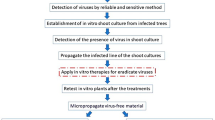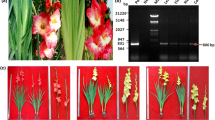Abstract
Raspberry bushy dwarf virus (RBDV) is one of the few horizontally transmitted plant viruses and is difficult to eradicate from infected raspberry (Rubus idaeus) by conventional methods because of its ability to infect meristematic cells in the apical dome. This virus is present where ever raspberry is grown and its adverse effects on quality and yield of the crop has necessitated development of methods to eradicate RBDV from infected stock plants. We applied ribavirin treatment (30 mg/L for 2 weeks—chemotherapy), thermotherapy (24 °C for 8 h in dark and 39 °C for 16 h with light for 2 weeks), cryotherapy (droplet vitrification of shoot tips) and their different combinations to assess the efficiency of virus eradication from an infected raspberry genotype. Virus testing was done on plantlets in tissue culture after 3–4 months following plant regeneration and repeated in half the population of virus-free plants in the greenhouse, 1 year after the initial test. Results showed that ribavirin treatment severely affected plant regeneration, resulting in low efficiency of virus eradication (10.6% regenerated plantlets free of RBDV out of all explants treated). When it was combined with thermotherapy, plant regeneration was significantly improved, resulting in higher efficiency of virus eradication (44.4%). When the shoot tips subjected to these two treatments were cryopreserved and regenerated, virus eradication efficiency further improved to 58.5%. The control of this treatment where plant material was not treated in liquid nitrogen produced the highest efficiency of virus eradication (78.8%), partly because of better plant regeneration. Thermotherapy and cryotherapy when applied alone failed to remove the virus from infected material; however, when combined, 48.6% efficiency of virus eradication was recorded. Inclusion of in vitro thermotherapy in combination with chemotherapy or cryotherapy or both is important to improve efficiency of RBDV eradication from infected raspberry. Nevertheless this virus can be eradicated by different approaches, and our results are useful for planning virus eradication programmes based on the efficiency of eradication. It is important to test the virus status after greenhouse acclimation, as virus may be suppressed and not completely eliminated in some treatments at tissue culture stage, as shown in ribavirin treatment in our research.
Key message
Eradication of Raspberry bushy dwarf virus from infected red raspberry is possible by chemotherapy, but the efficiency can be significantly improved when combined with thermotherapy or cryotherapy, or both.
Similar content being viewed by others
References
Agresti A, Coull BA (1998) Approximate is better than “exact” for interval estimation of binomial proportions. Am Stat 52(2):119–126. https://doi.org/10.1080/00031305.1998.10480550
Barnett OW, Murant AF (1970) Host range, properties and purification of Raspberry bushy dwarf virus. Ann Appl Biol 65(3):435–449. https://doi.org/10.1111/j.1744-7348.1970.tb05512.x
Bettoni JC, Dalla Costa M, Gardin JPP, Kretzschmar AA, Pathirana R (2016) Cryotherapy: a new technique to obtain grapevine plants free of viruses. Rev Bras Frutic. https://doi.org/10.1590/0100-29452016833
Bettoni JC, Souza JA, Volk GM, Dalla Costa M, da Silva FN, Kretzschmar AA (2019) Eradication of latent viruses from apple cultivar ‘Monalisa’ shoot tips using droplet-vitrification cryotherapy. Sci Hortic 250:12–18. https://doi.org/10.1016/j.scienta.2019.02.033
Bi W-L, Hao X-Y, Cui Z-H, Pathirana R, Volk GM, Wang Q-C (2018) Shoot tip cryotherapy for efficient eradication of grapevine leafroll-associated virus-3 from diseased grapevine in vitro plants. Ann Appl Biol 173(3):261–270. https://doi.org/10.1111/aab.12459
Botermans M, Van de Vossenberg B, Verhoeven JTJ, Roenhorst J, Hooftman M, Dekter R, Meekes E (2013) Development and validation of a real-time RT-PCR assay for generic detection of pospiviroids. J Virol Methods 187(1):43–50
Cadman CH (1952) Studies in Rubus virus diseases. IV. Yellows diseases of raspberries. Ann Appl Biol 39:495–500
Card SD, Pearson MN, Clover GRG (2007) Plant pathogens transmitted by pollen. Australas Plant Pathol 36(5):455–461. https://doi.org/10.1071/ap07050
Converse RH (1977) Rubus virus diseases important in the United States. HortScience 12:471–476
Daubeny HA, Freeman JA, StaceSmith R (1982) Effects of Raspberry bushy dwarf virus on yield and cane growth in susceptible red raspberry cultivars. HortScience 17:645–647
Ding F, Jin S, Hong N, Zhong Y, Cao Q, Yi G, Wang G (2008) Vitrification–cryopreservation, an efficient method for eliminating Candidatus Liberobacter asiaticus, the citrus Huanglongbing pathogen, from in vitro adult shoot tips. Plant Cell Rep 27(2):241–250. https://doi.org/10.1007/s00299-007-0467-8
Fry PR, Wood GA (1978) Two berry fruit virus diseases newly recorded in New Zealand. N Z J Agric Res 21(3):543–547. https://doi.org/10.1080/00288233.1978.10427447
Gallard A, Mallet R, Chevalier M, Grapin A (2011) Limited elimination of two viruses by cryotherapy of pelargonium apices related to virus distribution. Cryo Lett 32(2):111–122
Gamborg OL, Miller RA, Ojima K (1968) Nutrient requirements of suspension cultures of soybean root cells. Exp Cell Res 50(1):151–158. https://doi.org/10.1016/0014-4827(68)90403-5
Isogai M, Yoshida T, Nakanowatari C, Yoshikawa N (2014) Penetration of pollen tubes with accumulated Raspberry bushy dwarf virus into stigmas is involved in initial infection of maternal tissue and horizontal transmission. Virology 452–453:247–253. https://doi.org/10.1016/j.virol.2014.02.001
Isogai M, Suzuki Y, Matsudaira T, Yoshikawa N (2018) Genomic RNA accumulation of gentian ovary ring-spot virus and Raspberry bushy dwarf virus in pollen tubes. J Gen Plant Pathol 84(5):376–380. https://doi.org/10.1007/s10327-018-0795-2
Jones AT, Murant AF, Jennings DL, Wood GA (1982) Association of Raspberry bushy dwarf virus with raspberry yellows disease; reaction of Rubus species and cultivars, and the inheritance of resistance. Ann Appl Biol 100(1):135–147. https://doi.org/10.1111/j.1744-7348.1982.tb07200.x
Khan S, Mackay J, Liefting L, Ward L (2015) Development of a duplex one-step RT-qPCR assay for the simultaneous detection of Apple scar skin viroid and plant RNA internal control. J Virol Methods 221:100–105
King AMQ, Adams MJ, Carstens EB, Lefkowitz EJ (2012) Virus taxonomy ninth report of the international committee on taxonomy of viruses. Elsevier Academic Press, San Diego
Kudell AR, Buchenauer H (1989) Elimination of Raspberry Bushy Dwarf Virus from axillary bud cultures of red raspberry cv. Lloyd George by antiviral compounds. J Phytopathol 124(4):332–336. https://doi.org/10.1111/j.1439-0434.1989.tb04930.x
Lankes C (1995) Elimination of Raspberry Bushy Dwarf Virus. Acta Hoortic 385:70–75. https://doi.org/10.17660/ActaHortic.1995.385.8
Li BQ, Feng CH, Hu LY, Wang MR, Wang QC (2016) Shoot tip culture and cryopreservation for eradication of Apple stem pitting virus (ASPV) and Apple stem grooving virus (ASGV) from apple rootstocks ‘M9’ and ‘M26’. Ann Appl Biol 168(1):142–150. https://doi.org/10.1111/aab.12250
Linsmaier EM, Skoog F (1965) Organic growth factor requirements of tobacco tissue cultures. Physiol Plant 18(1):100–106
Markovic Z, Preiner D, Stupic D, Andabaka Z, Simon S, Voncina D, Maletic E, Kontic JK, Chatelet P, Engelmann F (2015) Cryopreservation and cryotherapy of grapevine (Vitis vinifera L.). Vitis 54:247–251
Menzel W, Jelkmann W, Maiss E (2002) Detection of four apple viruses by multiplex RT-PCR assays with coamplification of plant mRNA as internal control. J Virol Methods 99(1–2):81–92
Mink GI (1993) Pollen- and seed-transmitted viruses and viroids. Annu Rev Plant Physiol 31:375–402
Murant AF, Chambers J, Jones AT (1974) Spread of Raspberry bushy dwarf virus by pollination, its association with crumbly fruit, and problems of control. Ann Appl Biol 77(3):271–281. https://doi.org/10.1111/j.1744-7348.1974.tb01403.x
Murashige T, Skoog F (1962) A revised medium for rapid growth and bioassays with tobacco tissue cultures. Physiol Plant 15:473–497
Paprstein F, Sedlak J, Svobodova L, Polak J, Gadiou S (2013) Results of in vitro chemotherapy of apple cv Fragrance—Short communication. Hortic Sci 40(4):186–190
Paprstein F, Sedlak J, Talacko L (2014) In vitro chemotherapy of pear cultivars. Acta Hortic 1048:221–224
Pathirana R, McLachlan A, Hedderley D, Carra A, Carimi F, Panis B (2015) Removal of leafroll viruses from infected grapevine plants by droplet vitrification. Acta Hortic 1083:491–498. https://doi.org/10.17660/ACTAHORTIC.2015.1083.64
Pathirana R, Mathew L, Jibran R, Hunter DA, Morgan ER (2019) Cryopreservation and cryotherapy research on horticultural crops in New Zealand. Acta Hortic 1234:29–36. https://doi.org/10.17660/ActaHortic.2019.1234.4
Quito-Avila DF, Martin RR (2012) Real-time RT-PCR for detection of Raspberry bushy dwarf virus, Raspberry leaf mottle virus and characterizing synergistic interactions in mixed infections. J Virol Methods 179(1):38–44
Sakai A, Kobayashi S, Oiyama I (1990) Cryopreservation of nucellar cells of navel orange (Citrus sinensis Osb. Var. brasiliensis Tanaka) by vitrification. Plant Cell Rep 9(1):30–33. https://doi.org/10.1007/BF00232130
Skiada FG, Maliogka VI, Katis NI, Eleftheriou EP (2013) Elimination of Grapevine rupestris stem pitting-associated virus (GRSPaV) from two Vitis vinifera cultivars by in vitro chemotherapy. Eur J Plant Pathol 135(2):407–414. https://doi.org/10.1007/s10658-012-0097-z
Strik B, Martin RR (2003) Impact of Raspberry bushy dwarf virus on ‘Marion’ Blackberry. Plant Dis 87(3):294–296. https://doi.org/10.1094/PDIS.2003.87.3.294
Theiler-Hedtrich R, Baumann G (1989) Elimination of apple mosaic virus and Raspberry bushy dwarf virus from infected red raspberry (Rubus idaeus L.) by tissue culture. J Phytopathol 127(3):193–199. https://doi.org/10.1111/j.1439-0434.1989.tb01129.x
Vieira RL, da Silva AL, Zaffari GR, Steinmacher DA, de Freitas Fraga HP, Guerra MP (2015) Efficient elimination of virus complex from garlic (Allium sativum L) by cryotherapy of shoot tips. Acta Physiol Plant 37(1):1733. https://doi.org/10.1007/s11738-014-1733-3
Wang Q, Liu YG, Xie Y, You M (2006) Cryotherapy of potato shoot tips for efficient elimination of potato leafroll virus (PLRV) and potato virus Y (PVY). Potato Res 49:119–129
Wang QC, Cuellar WJ, Rajamäki ML, Hiraka Y, Valkonen JPT (2008) Combined thermotherapy and cryotherapy for virus eradication: relation of virus distribution, subcellular changes, cell survival and viral RNA degradation in shoot tips to efficient production of virus-free plants. Mol Plant Pathol 9:237–250
Wang QC, Laamanen J, Uosukainen M, Valkonen JPT (2005) Cryopreservation of in vitro-grown shoot tips of raspberry (Rubus idaeus L.) by encapsulation-vitrification and encapsulation-dehydration. Plant Cell Rep 24(5):280–288. https://doi.org/10.1007/s00299-005-0936-x
Wang QC, Valkonen JPT (2008) Elimination of two viruses which interact synergistically from sweetpotato by shoot tip culture and cryotherapy. J Virol Methods 154:135–145
Wang QC, Valkonen JPT (2009) Improved recovery of cryotherapy-treated shoot tips following thermotherapy of in vitro-grown stock shoots of raspberry (Rubus idaeus L.). Cryoletters 30(3):171–182
Weber CA (2016) Eliminating Raspberry bushy dwarf virus (RBDV) from infected raspberry tissue cultures with ribavirin. Acta Hortic 1133:473–478. https://doi.org/10.17660/ActaHortic.2016.1133.72
Wood GA (1995) Further investigations of Raspberry bushy dwarf virus in New Zealand. N Z J Crop and Hortic Sci 23(3):273–281. https://doi.org/10.1080/01140671.1995.9513899
Wood NT, McGavin WJ, Mayo MA, Jones AT (2001) Studies on a putative second gene in RNA-1 of Raspberry bushy dwarf virus. Acta Hortic 551:19–22
Zhang ZB, Haugslien S, Clarke JL, Spetz C, Blystad DR, Wang QC, Lee Y, Sivertsen A, Skjeseth G (2014) Cryotherapy could not eradicate Chrysanthemum stunt viroid from infected Argyranthemum maderense 'yellow empire'. Acta Hortic 1039:201–208
Zhao L, Wang MR, Cui ZH, Chen L, Volk GM, Wang QC (2018) Combining thermotherapy with cryotherapy for efficient eradication of Apple stem grooving virus from infected in-vitro-cultured apple shoots. Plant Dis 102(8):1574–1580. https://doi.org/10.1094/pdis-11-17-1753-re
Acknowledgements
We thank John Mackay (dnature.co.nz) for help with initial set up of the RBDV/NAD probe chemistry, Andrew Mullan and Sriya Pathirana for tissue culture media preparation and Julie Ryan for help in the greenhouse. We also thank Janice Turner and Jenny Gaudion for the supply of plantlets in tissue culture.
Author information
Authors and Affiliations
Contributions
RP and DH conceptualised the project; RP managed the project; AM conducted the statistical analysis; LM, ZE, HT, RP and DH conducted the research work; RP and DH wrote the manuscript; all authors read the manuscript, edited and approved the final version.
Corresponding author
Ethics declarations
Conflict of interests
The authors declare they have no conflict of interest.
Additional information
Communicated by M. Angeles Revilla.
Publisher's Note
Springer Nature remains neutral with regard to jurisdictional claims in published maps and institutional affiliations.
Rights and permissions
About this article
Cite this article
Mathew, L., Tiffin, H., Erridge, Z. et al. Efficiency of eradication of Raspberry bushy dwarf virus from infected raspberry (Rubus idaeus) by in vitro chemotherapy, thermotherapy and cryotherapy and their combinations. Plant Cell Tiss Organ Cult 144, 133–141 (2021). https://doi.org/10.1007/s11240-020-01829-y
Received:
Accepted:
Published:
Issue Date:
DOI: https://doi.org/10.1007/s11240-020-01829-y




